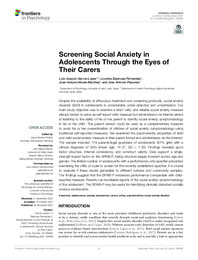Por favor, use este identificador para citar o enlazar este ítem:
https://hdl.handle.net/11000/36097Registro completo de metadatos
| Campo DC | Valor | Lengua/Idioma |
|---|---|---|
| dc.contributor.author | Garcia-Lopez, Luis-Joaquin | - |
| dc.contributor.author | Espinosa Fernández, Lourdes | - |
| dc.contributor.author | Muela-Martinez, Jose-Antonio | - |
| dc.contributor.author | Piqueras, Jose A | - |
| dc.contributor.other | Departamentos de la UMH::Psicología de la Salud | es_ES |
| dc.date.accessioned | 2025-03-24T16:17:04Z | - |
| dc.date.available | 2025-03-24T16:17:04Z | - |
| dc.date.created | 2021-12-02 | - |
| dc.identifier.citation | Frontiers in Psychology , 02 December 2021, Sec. Psychology for Clinical Settings, Volume 12 - 2021 | es_ES |
| dc.identifier.issn | 1664-1078 | - |
| dc.identifier.uri | https://hdl.handle.net/11000/36097 | - |
| dc.description.abstract | Despite the availability of efficacious treatment and screening protocols, social anxiety disorder (SAD) in adolescents is considerably under-detected and undertreated. Our main study objective was to examine a brief, valid, and reliable social anxiety measure already tested to serve as self-report child measure but administered via Internet aimed at listening to the ability of his or her parent to identify social anxiety symptomatology in his or her child. This parent version could be used as a complementary measure to avoid his or her overestimation of children of social anxiety symptomatology using traditional self-reported measures. We examined the psychometric properties of brief and valid social anxiety measure in their parent format and administered via the Internet. The sample included 179 parents/legal guardians of adolescents (67% girls) with a clinical diagnosis of SAD (mean age: 14.27; SD = 1.33). Findings revealed good factor structure, internal consistency, and construct validity. Data support a single, strength-based factor on the SPAIB-P, being structure largely invariant across age and gender. The limited number of adolescents with a performance-only specifier prevented examining the utility of scale to screen for this recently established specifier. It is crucial to evaluate if these results generalize to different cultures and community samples. The findings suggest that the SPAIB-P evidences performance comparable with childreported measure. Parents can be reliable reports of the social anxiety symptomatology of the adolescent. The SPAIB-P may be useful for identifying clinically disturbed socially anxious adolescents. | es_ES |
| dc.format | application/pdf | es_ES |
| dc.format.extent | 6 | es_ES |
| dc.language.iso | eng | es_ES |
| dc.publisher | Frontiers Media | es_ES |
| dc.rights | info:eu-repo/semantics/openAccess | es_ES |
| dc.rights | Attribution-NonCommercial-NoDerivatives 4.0 Internacional | * |
| dc.rights.uri | http://creativecommons.org/licenses/by-nc-nd/4.0/ | * |
| dc.subject | adolescence | es_ES |
| dc.subject | anxiety | es_ES |
| dc.subject | assessment | es_ES |
| dc.subject | carers | es_ES |
| dc.subject | online | es_ES |
| dc.subject | psychometrics | es_ES |
| dc.subject | social anxiety disorder | es_ES |
| dc.subject.other | CDU::1 - Filosofía y psicología::159.9 - Psicología | es_ES |
| dc.title | Screening Social Anxiety in Adolescents Through the Eyes of Their Carers | es_ES |
| dc.type | info:eu-repo/semantics/article | es_ES |
| dc.relation.publisherversion | https://doi.org/10.3389/fpsyg.2021.769006 | es_ES |

Ver/Abrir:
2021_fpsyg-12-769006.pdf
225,42 kB
Adobe PDF
Compartir:
 La licencia se describe como: Atribución-NonComercial-NoDerivada 4.0 Internacional.
La licencia se describe como: Atribución-NonComercial-NoDerivada 4.0 Internacional.
.png)